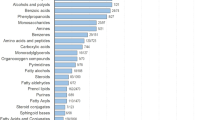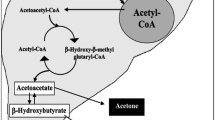Summary
Human breath contains hundreds of trace volatile organic compounds. These volatile substances may be generated in the body or may be absorbed as contaminants from the environment. Some of the endogenous substances are characteristic markers of pathophysiological processes and clinicians are already using breath testing of such substances as an additional non-invasive diagnostic tool for certain diseases. Isoprene, another volatile compound, is formed endogenously in humans, and while the biochemical pathways of biosynthesis and exact origins of isoprene found in human breath have not been elucidated in sufficient depth, its measurement in exhaled breath has been suggested as a non-invasive indicator with diagnostic potential. This test has not yet reached the level of routine clinical methods and is still under development. Breath isoprene levels have been reported to be altered in a number of clinical conditions; however, the physiological meaning of these changes has not been established. Various lines of supportive evidence suggest that isoprene is related to cholesterol biosynthesis. Therefore, breath isoprene measurements could potentially be used for mass screening for lipid disorders and could, at minimum, serve as an additional parameter to complement invasive tests for monitoring the efficacy of lipid-lowering therapy, pharmacological and dietary or lifestyle. As a potentially useful biomarker of mevalonate synthesis in humans, it may have non-invasive applications, not only in metabolic disorders, but possibly also in cancer screening. In the present work, we aim to give a concise overview of breath isoprene, its measurement techniques, problems concerning its physiological meaning, and potential applications as a non-invasive biomarker in modern medicine.
Zusammenfassung
Der menschliche Atem enthält hunderte flüchtige Spurenelemente. Diese volatilen Substanzen können Produkte des Körpers sein oder von absorbierten Verunreinigungen der Umwelt stammen. Manche der endogenen Substanzen sind charakteristische Marker von pathophysiologischen Vorgängen. Klinisch werden daher Bestimmungen solcher Substanzen in der Atemluft bereits als zusätzliche nicht-invasive diagnostische Hilfsmittel für bestimmte Erkrankungen verwendet. Die volatile Substanz Isopren wird endogen im menschlichen Körper erzeugt. Die biochemische Biosynthese und der genaue Herkunftsort dieser Substanz im menschlichen Atem ist bis jetzt unzureichend geklärt. Trotzdem wird ihrer Bestimmung in der Ausatemluft ein diagnostisches Potenzial zugeschrieben. Dieser nicht-invasive Test ist allerdings noch in Entwicklung und hat noch nicht in die klinische Routine Eingang gefunden. Die Konzentration von Isopren in der Atemluft scheint bei verschiedenen klinischen Bedingungen verändert zu sein. Die physiologische Bedeutung dieser Beobachtung ist jedoch unklar. Vieles deutet darauf hin, dass die Cholesterin-Biosynthese mit Isopren im Zusammenhang steht. Ein mögliche Verwendung ist daher der Einsatz im Massen-Screening auf Störungen des Fettstoffwechsels. Zumindest könnte es als zusätzlicher nicht-invasiver Parameter zur Beurteilung der Wirksamkeit von lipidsenkenden Maßnahmen (pharmakologisch, diätetisch oder Lebensstil) dienen. Aber nicht nur bei Stoffwechselerkrankungen ist ein Einsatz denkbar: auch beim Screening auf Krebserkrankungen ist es als Biomarker der Mevalonat-Synthese vorstellbar. In der vorliegenden Arbeit haben wir versucht, einen einen konzisen Überblick über Isopren in der Atemluft zu geben. Die Bestimmungsmethoden, die Probleme seiner physiologischen Bedeutung, sowie sein möglicher Einsatz als nicht-invasiver Biomarker in der modernen Medizin werden dargelegt.
Similar content being viewed by others
Author information
Authors and Affiliations
Corresponding author
Rights and permissions
About this article
Cite this article
Salerno-Kennedy, R., Cashman, K.D. Potential applications of breath isoprene as a biomarker in modern medicine: a concise overview. Wien Klin Wochenschr 117, 180–186 (2005). https://doi.org/10.1007/s00508-005-0336-9
Received:
Accepted:
Issue Date:
DOI: https://doi.org/10.1007/s00508-005-0336-9




